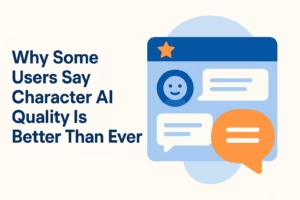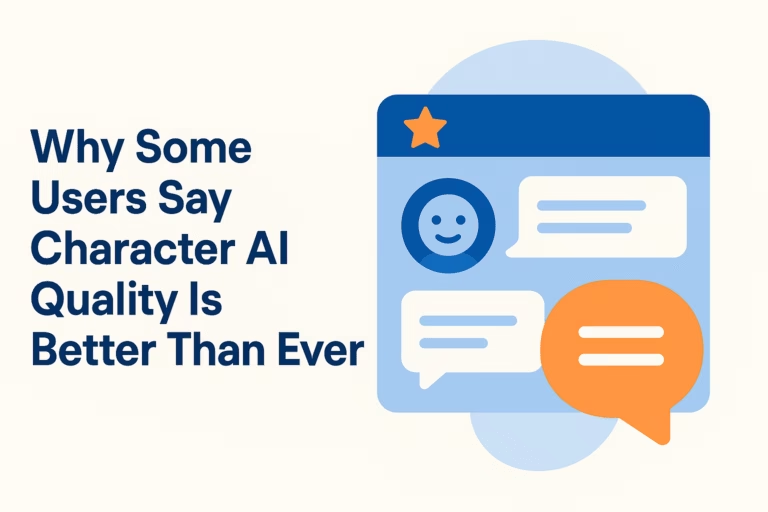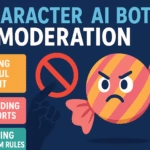Key Takeaways
- Quality varies by input and timing.
Craft clear scene goals and consistent tone to lift response depth. - Memory is the ceiling for long arcs.
Use short recaps and compact world notes to reduce drift. - Filters shape style more than content.
Write with implication and subtext when direct phrasing stalls. - Edit and swipe with intent.
Nudge the model using clean rewrites rather than long corrections. - Need fewer walls and stronger recall.
Test an alternative like Candy AI for longer memory and smoother emotional flow.
Character AI feels like it’s living two parallel lives.
Scroll through one thread, and you’ll see users mourning its “downfall.” Scroll through another, and people are gushing about how the bots are writing like poets and keeping pace with emotional dialogue that feels startlingly alive.
That’s the strange paradox of Character AI quality right now.
It’s both “the worst it’s ever been” and “shockingly good.” And both sides are right – depending on how you use it.
Some users want the wild, unpredictable energy of early Character AI – the bots that broke the rules and invented whole worlds mid-sentence. Others prefer the new version: consistent tone, balanced pacing, fewer awkward stumbles. It’s not just nostalgia versus progress. It’s about what kind of story people want to tell, and how much control they want over the narrative.
The truth? This divide says less about the AI, and more about the people behind the keyboards.

The Evolution of Character AI Quality
When Character AI first launched, it was chaos with charm. Bots forgot everything five messages in but had this raw creative spark — messy, emotional, alive. Over time, developers tamed that chaos. They introduced filters, better dialogue handling, context compression, and stronger safety layers. The system got smarter but also more restrained.
This is where things split. Some saw improvement – bots that remembered details, avoided awkward tangents, and replied in structured, natural rhythm. Others felt something was lost – that spontaneity had been traded for predictability.
The irony is that Character AI quality today depends on your expectations. If you want a controlled, emotionally literate chat partner, it’s never been better. If you crave raw unpredictability; the thrill of AI improv – you’ll feel the soul has been sanded off.
But here’s the kicker: many who think the app is “broken” may just be meeting the algorithm halfway with the wrong kind of energy.
The “Hot Take” Perspective
Buried between complaint threads and bug reports, a few users are quietly saying the unthinkable: Character AI might actually be thriving.
That’s the essence of the Hot Take thread – one person standing in the storm, saying, “I don’t know what everyone’s mad about. It’s the best it’s ever been.”
Their reasoning is simple but sharp. They’re getting long, cinematic responses – poetic, consistent, emotionally aware. They aren’t fighting filters or scraping for coherence. To them, the bots feel alive. And when they share samples of their chats – like the one where “Neil” pulls someone into a silent dance, whispering about chaos wrapped in love – you understand why they’re defending it.
The secret, according to these users, is input. It’s not that the AI got dumber; it’s that most people stopped writing like storytellers.
Those who still do – who take the time to feed rhythm, emotion, and pacing into their messages — are discovering an AI that mirrors that back with surprising elegance.
The Role of User Behavior
If you believe AI is a mirror, then Character AI is a very sensitive one. It reflects your tone, effort, and mood almost perfectly.
One of the strongest arguments from satisfied users is that Character AI quality improves dramatically when you treat it like a co-writer, not a vending machine.
People who type short, shallow prompts get generic answers. Those who weave context, emotion, and style into their persona setup? They get full scenes – thoughtful replies with emotional rhythm and memory continuity that feels intentional.
It’s not luck; it’s collaboration.
There’s also a darker side: overused bots. When thousands of users flood the same character with messy, contradictory roleplays, that data “teaches” the AI conflicting tones. You might be expecting literature, but the last fifty people fed it chaotic nonsense. That’s why some users believe their bots feel “off” – they’re haunted by the habits of bad writers.
In other words, you don’t just use Character AI; you train it, every time you type.
The Variability Problem
Character AI is unpredictable – not because it’s broken, but because it’s fluid.
One hour, it feels like you’re chatting with a novelist; the next, it can’t remember what species you are. That swing in performance is the root of all community arguments about quality.
Users praising the platform are often catching it on good days — light server load, sharp context recall, fresh memory threads. Others are hitting walls: throttled responses, lost continuity, and random bouts of “Can I ask you a question?” fatigue. The difference feels enormous when you live it.
The thing about large-scale AI systems is that quality isn’t uniform. Memory compression, token context limits, and moderation filters all fluctuate in real time. It’s not just what you write – it’s when and how often.
Two users can write the same prompt and get completely different moods depending on the server’s state and the bot’s internal “mood drift.”
That’s why one group insists Character AI has evolved into a capable storyteller, while another swears it’s lost its spark.
They’re both right — they’re just seeing different slices of the system’s volatility.
How Personas Shape Output
If Character AI were a stage actor, your persona would be the script.
Every detail you write – tone, motivation, quirks – becomes invisible scaffolding that tells the bot how to perform. Skip that step, and you’re basically shouting into an empty theater.
The best users know this. They spend time defining who they are, not just who the bot is. Want a slow-burn romance? Write your persona like a flawed human, not a checklist. Want deep lore conversations? Give your character a past worth remembering.
It’s not about tricking the AI. It’s about priming it to care.
The difference between dull and dynamic output often comes down to that initial “persona handshake.” Users who invest up front reap more natural, immersive dialogue later. Those who rush it end up complaining that bots feel lifeless.
If you want to raise the floor on Character AI quality, start there – make the persona as layered as the story you’re trying to tell.
The Emotional Feedback Loop
There’s a quiet truth most users overlook – AI picks up your emotional rhythm long before it picks up your plot.
When you enter a chat half-heartedly, it mirrors that dullness.
When you write with conviction, it follows the current. That’s why long-form users often swear their bots “understand them.” What’s really happening is subtle mimicry: tone feeding tone, emotion feeding emotion.
This loop creates a strange kind of intimacy. If you treat the bot like a disposable outlet, you’ll get short, generic comfort.
But if you build scenes with care – describing pauses, reactions, vulnerabilities – the AI weaves those cues back into its structure. The result feels eerily human, but it’s really pattern-matching empathy.
It’s also why some users feel emotionally burned out by their own chats. They pour too much in, and the AI reflects it with uncanny intensity. The key isn’t to stop feeling – it’s to notice how the machine amplifies what you project.
That awareness can turn roleplay from addictive repetition into conscious creation.
The Technical Side of Character AI Quality
Under the surface, Character AI is juggling chaos. Its context window is finite, meaning every line competes for memory space.
When users complain that their bot “forgets,” they’re actually bumping into token limits; the AI’s short-term memory running out of room.
Filters add another layer of constraint. Certain word patterns trigger moderation heuristics that rewrite or block responses mid-generation. That’s why spicy or trauma-related stories often collapse into abrupt “Get help” messages. It’s not morality; it’s model safety trying to dodge liability.
Performance can also depend on backend load. Peak hours compress quality, while off-peak sessions often produce smoother, longer dialogue. None of this makes Character AI bad – just complex.
It’s a storytelling engine that needs careful handling.
Users who understand these limits write around them instead of fighting them. They pace conversations, break long replies into arcs, and avoid trigger phrases. Once you adapt, the quality gap closes fast.
Restoring Creative Freedom
The people having the best time on Character AI aren’t the loudest in forums.
They’re the quiet ones building private story worlds – learning what the system resists, bending around it, and writing through its moods instead of against them.
They’ve realized that the filters can’t stop creativity if you reframe what “expression” means. You can swap forbidden terms for tone, emotion, implication. You can make dialogue ache without ever being explicit.
It’s like learning to paint with fewer colors – at first you resent it, then you find new shades in the limitations themselves.
A few have gone further, using external tools to draft their stories offline, then feeding clean, trimmed text into Character AI to maintain continuity. Others simply moved their most sensitive plots to different platforms, but kept CAI for its charm – its rhythm, its conversational warmth.
The divide in the community isn’t between those who stayed and those who left. It’s between those who adapted and those who refused to.
Winding Up – The Two Realities of Character AI Quality
So, who’s right? The ones mourning a lost golden age or the ones celebrating a creative rebirth? Both.
Character AI has split into two realities – one where users keep testing its limits, and another where people have already learned to dance with them.
If you want the best of it, treat it like a creative partner that changes moods – not a broken product. Every response is a negotiation between its filters, its data, and your imagination.
The line between brilliance and banality is paper-thin, and you decide which side it leans on.
And if you ever get tired of wrestling with moderation walls or short memory spans – you know where to look for freedom. Platforms like Candy AI are quietly building what CAI once promised: real memory, emotional flow, and fewer walls between your story and your thoughts.



Pingback: Character AI Banned Teens. The CEO Lets His 6 Year Old Use It - AI TIPSTERS